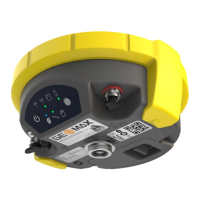Accuracy is dependent upon various factors including the number of satellites tracked, constella-
tion geometry, observation time, ephemeris accuracy, ionospheric disturbance, multipath and
resolved ambiguities.
The accuracies, given as root mean square, are based on measurements processed using
GeoMax Geo Office and on real-time measurements.
The use of multiple GNSS systems can increase accuracy by up to 30% relative to GPS only.
6.1.3 GNSS antenna specifications
Description Value
Phase centre error ± 2 mm
LNA gain Typically 33 dBi
Noise figure Typically ≤ 2.5 dBi
6.1.4 Internal devices
Description Value
GSM/UMTS module
(only available on
Zenith40)
Cinterion PHS8
Quad-Band GSM 850/900/1800/1900 MHz
Penta-Band UMTS 800/850/900/1900/2100 MHz
UHF radio module Satel M3-TR4, transceiver
Transmission power 0.5 and 1.0 W
Frequency range 403 to 473 MHz
Bluetooth Class 2
6.1.5 Technical Data
Description Value
Height 95 mm/3.7"
Diameter 198 mm/7.8"
Description Value
GNSS receiver weight without battery,
SIM card and SD card
Zenith16: 1.09 kg to 1.13 kg
Zenith40: 1.14 kg to 1.18 kg
(depeding on configuration)
GNSS raw data can be recorded on a microSD card.
1 GB is sufficient for over 1 year of raw data logging based on logging every 15 s from an aver-
age of 15 satellites.
Description Value
Internal battery Li-Ion battery 7.4 V/2.6 Ah
External power input 10.5 V to 28 V DC with ZDC225 cable
Power consumption Typically 2.0 W without radio
☞
GNSS antenna specifica-
tions
Internal devices
Dimensions
Weight
Recording
Power
Technical Data 29

